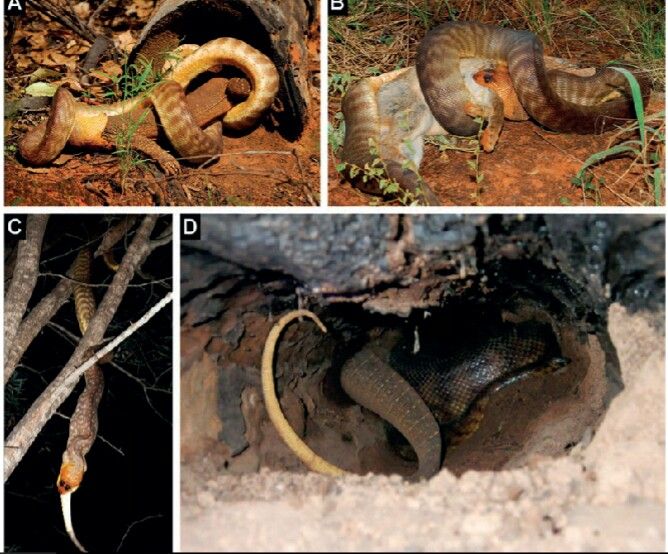Post by Ceratodromeus on May 1, 2015 21:25:51 GMT 5

Scientific classification
Kingdom: Animalia
Phylum: Chordata
Subphylum: Vertebrata
Class: Reptilia
Order: Squamata
Suborder: Serpentes
Family: Pythonidae
Genus: Aspidites
Species: Aspidites ramsayi
Conservation status: endangered
Description: the woma is a mid sized python. of the 74 individuals taken in a study, A. ramsayi averaged 148cm(4.8ft) and the largest, a male, maxed out at 220cm(7.2 ft) {1}. In some parts of its range it is commonly reported at 5kg. Its coloration is predominately brown and yellowish white bars going own the entirety of its body. the head is orange or red with black markings above the eyes and at the end of the snout. They lack the heat recepting pits of most other pythons, perhaps this is why they have the dietary habits like the closely relate black headed python. It is mainly a nocturnal animal, but frequently roams during day time hours.
Distribution: this snake is found in the interior of Australia and on the coast near Shark bay.

They inhabit arid regions, usually sticking to pockets of canegrass or the burrows of small mammals -- in which they will eat the residents first before staking the burrows as their own.
Dietary habits: Like its close relative the Black Headed Python (A. melanocephalus), the Woma eats pimarily reptiles -- a favorite being the Spiny Tailed Monitor (V. acanthurus) in some locales they are more apt to take rodents when offered, though. Something worth noting is that these snakes don't use typical constriction -- they feed maly in burrows, grabbing a prey animal and squashing it against the wall, sometimes throwing a coil over said prey item to prevent it from escaping{2}.
Predators: the Mulga Snake is a rather active predator of this python. To what degree was not really noted until reintroduction of the woma was attempted in 2011.{3} A small passage from the study documenting this:
" Results
The most noteworthy outcome of this study was that all released woma pythons were dead between 41 and 123
days following release, either definitely or most likely killed by Mulga Snakes. Three python mortalities were attributed to at least two, probably three, different mulga snakes. Two of these womas were eaten by different mulga snakes that continued to be radio-tracked until they excreted their transmitters 33 and 23 –27 days later. The other woma (# 98 )was observed being repeatedly struck and dragged around by a mulga snake but was not swallowed. Three other womas were most likely killed by mulga snakes thatwere observed entering woma burrows immediately before their death (#97) or they were located near death or dead with severe bruising and/or heart and lung damage con-sistent with mulga snakes."
...
The final woma transmitter (#99) was lost after it had moved widely on a swale for several days without being sighted, which was consistent with the movements of both mulga snakes known to have consumed womas. We assume that this woma was swallowed by a mulga snake shortly before the long-distance movements of its transmitter commenced. "
aside fom the Mulga Snake, feral cats and foxes also have been known to prey on this snake. raptorial birds and other reptiles are also known predators.
Reproduction: the mating season occurs from may - july, with the eggs hatching 50-65 days later. A typical clutch size is 6-8 eggs, though larger females have been reported to lay more.

the eggs are small, and the neonate(newly hatched) snakes are ~6 inches in length.
References
{1}Shine, Richard, and David J. Slip. "Biological aspects of the adaptive radiation of Australasian pythons (Serpentes: Boidae)." Herpetologica (1990): 283-290.
{2}HOSER, RAYMOND T. "AUSTRALIAN PYTHONS (PART THREE)."
{3}Read, J. L., G. R. Johnston, and T. P. Morley. "Predation by snakes thwarts trial reintroduction of the Endangered woma python Aspidites ramsayi." Oryx 45.04 (2011): 505-512.



